McLuhan’s Technological Determinism
- McLuhan argued that media dictates social change.
- He introduced “The medium is the message”.
- McLuhan focused on medium rather than content.
- A Medium is an extension of humans.
- Every medium encourages different habits in society.
- Electronic media has retribalized the human face.
- Digital technology influences the way humans interact.
- Media technologies increases people’s control over time.
- Dominant media alters the social life’s rhythm.
- Electronic media have facilitated social boundaries’ transcension.
- These technologies alter people’s sense of space.
- They also alter people’s sense of community.
- Wireless technologies have led to network societies.
- Electronic media has introduced online communication culture.
According to Marshall McLuhan, technological determinism is the view that media technologies determine processes of social change. It includes books, newspapers, telephone, social networking sites, email, or websites (Croteau & Hoynes, 2018).
Based on his aphorism “The medium is the message”, McLuhan debunks the notion that media is a mere channel delivering messages.
Unlike media content, that the medium has the capability to reform human experience and exert more societal changes than total number of messages they carry (Giotta, 2017).
Unlike in the past where broadcast media required a live audience, nowadays people can download or save content for later viewing, enabling people to have more control over time (Croteau & Hoynes, 2018).
The introduction of cable news channel that air news throughout the day has broken previous monotony of waiting for news updates at specific times of the day, altering social life’s rhythm.
Media technologies have also surpassed social boundaries as minors are now exposed to adult content (Giotta, 2017).


Social Forces
- Critics argue that social forces determine technologies.
- They focus on people rather than medium.
- Human agency dictates usage of media technologies.
- Social dynamics can alter future technological development.
- Media technologies are products of human invention.
- Electronic communications resemble bodily resourced communicative modes.
- Economic pressures greatly influence new media application.
- McLuhan’s critics argue that media technologies are dictated by social forces such as human agency, economic pressures, cultural norms, and legal and policy regulations (Croteau & Hoynes, 2018).
- These technologies are seen as products of human’s invention and they imitate bodily communicative modes such as gestural, visual, linguistic and spatial abilities.
- Economic pressures have been considered to be the major social forces behind technological forces as major media firms seek ways to generate revenue from the opportunities brought by these platforms.
McLuhan’s critics argue that media technologies are dictated by social forces such as human agency, economic pressures, cultural norms, and legal and policy regulations (Croteau & Hoynes, 2018).
These technologies are seen as products of human’s invention and they imitate bodily communicative modes such as gestural, visual, linguistic and spatial abilities.
Economic pressures have been considered to be the major social forces behind technological forces as major media firms seek ways to generate revenue from the opportunities brought by these platforms.
Media technologies such as Netflix, Twitter, and Instagram have offered platforms where marketers and businesses can promote their brands, changing these sites to advertising hubs.
Legal systems are gradually imposing restrictions on social media usage through government regulations. However, Big Tech industry remains largely unregulated.
Cultural norms limit online activities, especially for children through parental mediation strategies such as time restriction and use of shared computers to reduce time spent on internet and alleviate their exposure to explicit content (Shin, 2013).
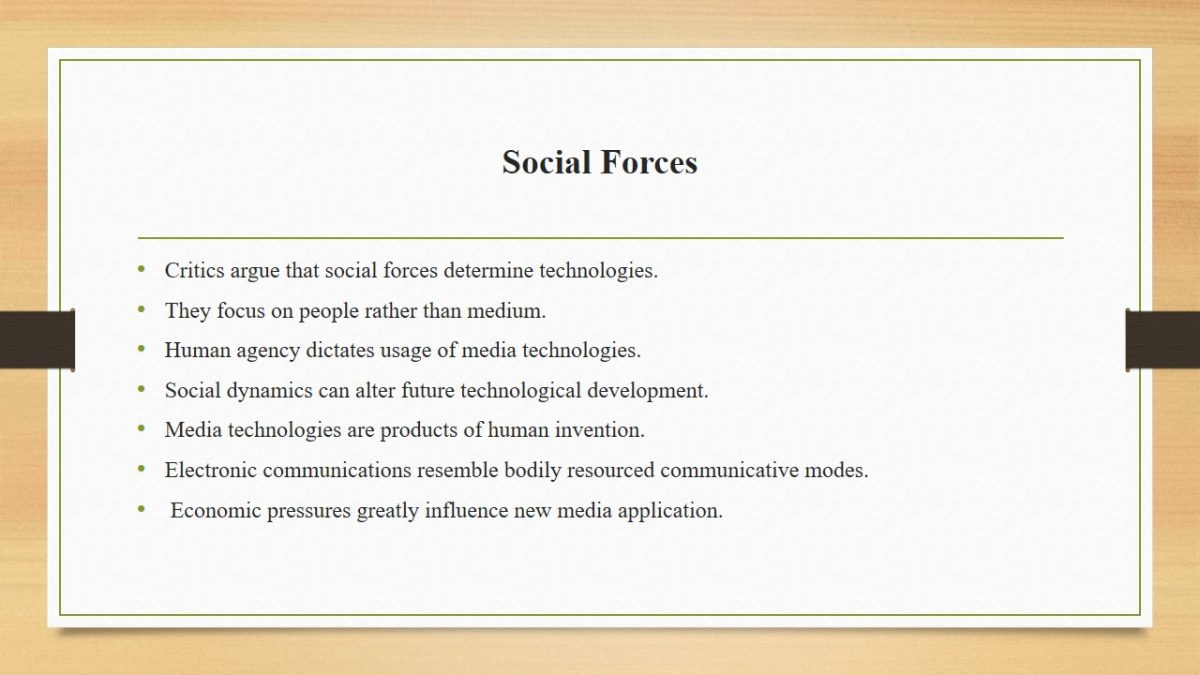

What Stands Out While Juxtaposing McLuhan’s Technological Determinism and Social Forces?
- New technologies changes society at every level.
- Social phenomena can be shaped by technology.
- Media companies generate their revenue from advertisements.
- Users’ preferences influence evolution of these technologies.
- Importance of media technologies cannot be overemphasized.
- Significance of social forces cannot be underrated.
- New media is interrelated with social forces.
Juxtaposition between McLuhan’s technological determinism and social forces presents numerous outstanding themes. For instance, technologies can change society at every level including science, politics, entertainment, education and health (Giotta, 2017).
While media technologies such as TV and social networking sites may be viewed as mere platforms for communication, they mainly depend on advertisements to gain revenues for their sustainability.
New media such as online stream are interconnected with social forces as they are developed to meet consumer’s changing needs (Shin, 2013).
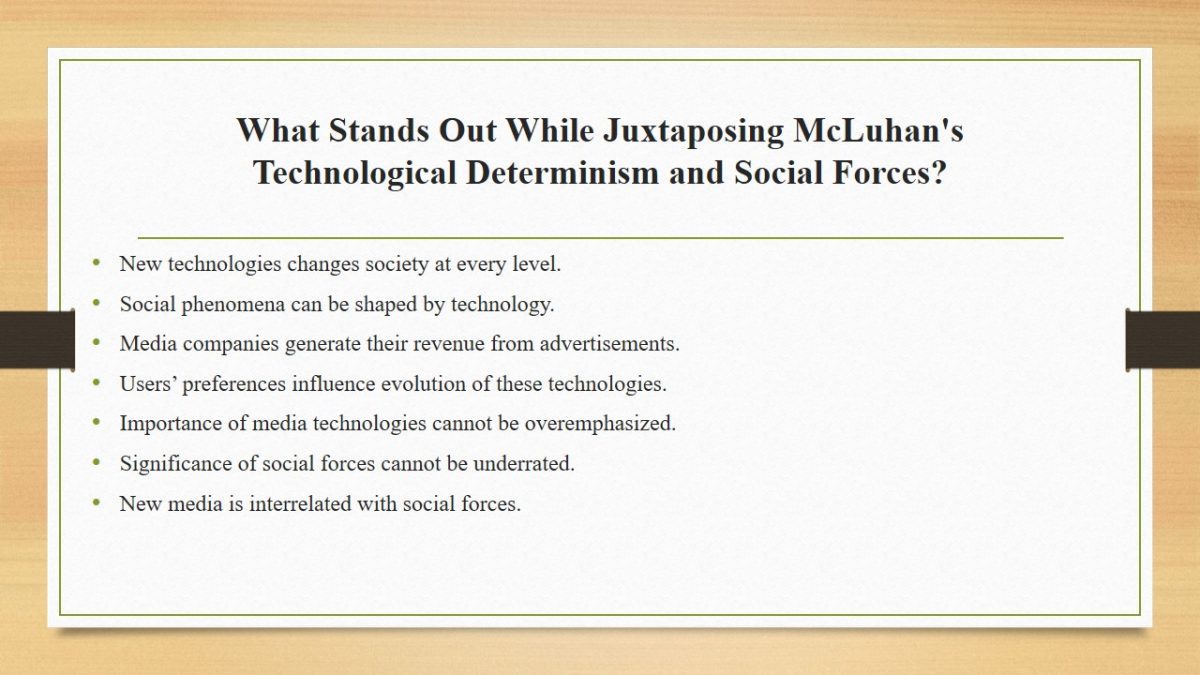
One Difference Between McLuhan’s Technological Determinism and Social Forces
- Despite the social determinists’ argument that technology is an effect of sociocultural change, McLuhan fails to acknowledge that humans determine its success or failure (Giotta, 2017).
- McLuhan argues that media technologies can change human behaviors independent of social forces, which is widely disputed by his critics who believe that these two areas are mutually dependent.
Technological determinism does not consider human agency while social forces acknowledge inherent capacities of various media. While McLuhan views technology as “the principal mover” of social changes, his critics agree that these platforms have had substantial contributions to society (Giotta, 2017). For instance, their ability to connect people worldwide and act as sources of vast and knowledgeable information (Croteau & Hoynes, 2018). This difference indicates that technological determinism completely ignores the significance of human factors.
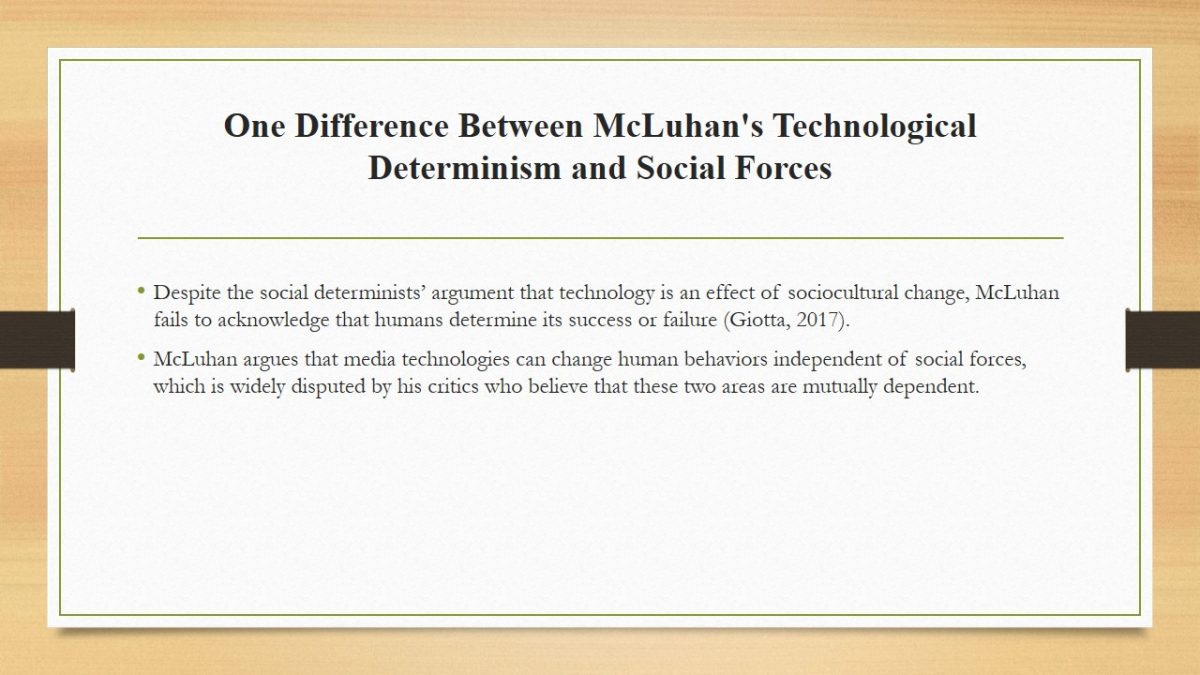
One Similarity Between McLuhan’s Technological Determinism and Social Forces
- Social forces and McLuhan’s technological determinism have also contributed to social media addiction as people increasing become over reliant on the internet.
- Both have facilitated the growth of international trade and are also designed to alter people’s behaviors (Giotta, 2017).
Technological determinism and social forces are crucial agents of sociocultural change. For instance, media technologies have created a culture where online communication has become primary, especially for younger generation. Similarly, social forces have altered people’s perspective of technology. For instance, business enterprises have embraced it as a perfect platform for marketing their products and services. Moreover, the two have contributed to changes in business operations where the need to shift to online shopping has led to the emergence of such platforms as Amazon and Alibaba.
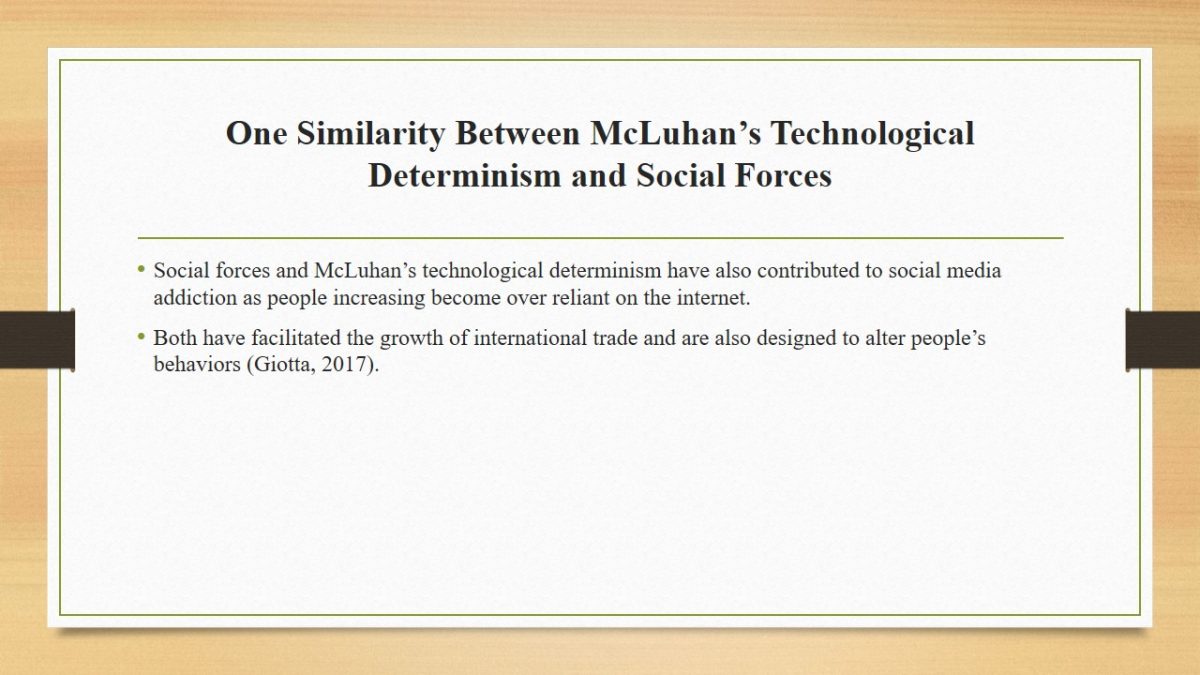
Personal Position/Perspective Of Mcluhan’s Technological Determinism and Social Forces
- Technological determinism and social forces are inter-dependent.
- The two lead to significant sociocultural changes.
- Effects of both to society are inevitable.
- Social forces are superior to technological determinism.
- Technological determinism supports usage of media technologies.
- Social forces can discourage new technology’s adoption.
- Technological determinism should not ignore social forces.
Based on my perspective/position of technological determinism and social forces, I believe that the two are inter-dependent. This association means that they media technologies cannot exists in the absence of such human factors as economic factors and changing cultural norms. Similarly, social forces depend media technologies due to their inherent capacities to numerous solutions to users.
Technological determinism is inferior to social forces due to the fact that some factors such as government regulation can completely bar usage of media technologies.
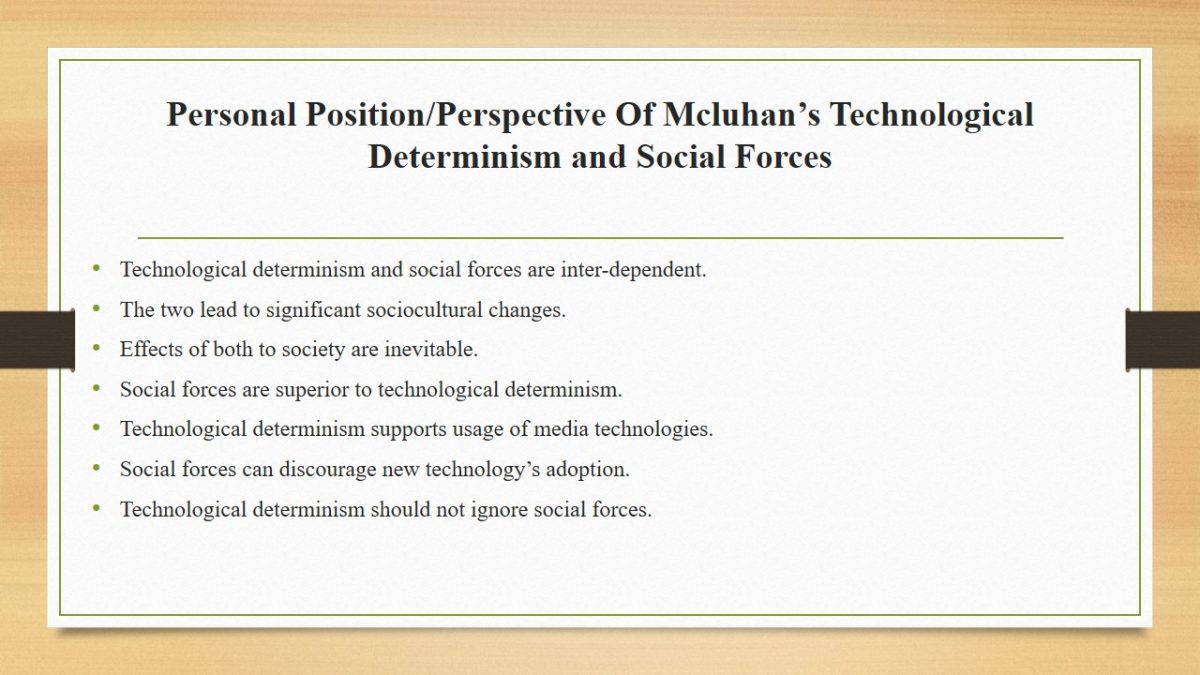
References
Croteau, D., & Hoynes, W. (2018). Media/Society: Technology, industries, content, and users. SAGE Publications.
Giotta, G. (2017). Teaching technological determinism and social construction of technology using everyday objects. Communication Teacher, 32(3), 136–140. Web.
Shin, W. (2013). Parental socialization of children’s Internet use: A qualitative approach. New Media & Society, 17(5), 649–665. Web.